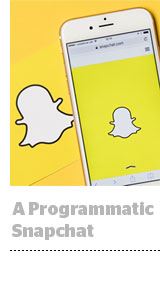 Snapchat’s ads API works. And the ad platform is hitting product development milestones earlier than other social platforms, according to buyers participating in the API’s beta.
Snapchat’s ads API works. And the ad platform is hitting product development milestones earlier than other social platforms, according to buyers participating in the API’s beta.
It’s the benefit of last-mover advantage, said Noah Mallin of MEC Global. “They’ve seen all the pitfalls and all the successes.”
The Ins And Outs Of Snapchat’s Programmatic Platform
Snapchat first released its ads API in October with nine partners, including Adaptly and 4C, and the current beta version enables critical marketing tasks like CRM audience matching, third-party measurement and basic targeting by age, gender, location and content consumption behavior.
The company also recently added campaign optimization based on ad interactions and integrated with Oracle-owned Datalogix, so marketers can better target and measure sales results.
Snapchat has also worked to alleviate early concerns around poor reporting, embracing third-party measurement last June and partnering with nine outside measurement partners, including Moat, Google DoubleClick and Sizmek. It also offered brand-lift studies from partners Millward Brown and Nielsen.
“The rate at which Snapchat has reached parity on a number of important ad products has been extremely impressive,” said Adaptly President Sean O’Neal. “And they’ve done so more rapidly than many other platforms preceding them.”
The stakes are high as Snapchat prepares for an IPO and attempts to take on Facebook as the go-to social platform. And the competition is creeping up: Instagram Stories recently announced it had amassed 150 million daily users, the same number as Snapchat.
But some buyers think the fundamental differences between Snapchat and Facebook may preclude Snapchat from becoming the dependable, efficient choice to deploy a massive amount of marketing spend.
These differences may determine Snapchat’s fate. It might be a viable Facebook competitor, or it might settle into a niche role and never attain the heights of the blue behemoth.
Snapchat’s Issues With Efficiency And Scale
AdExchanger Daily
Get our editors’ roundup delivered to your inbox every weekday.
Daily Roundup
Despite Snapchat’s enhancements to its ad product, some buyers say it’s not as efficient as other social marketing channels.
“They are not as efficient, not by any stretch of the imagination,” said James Douglas, SVP and executive director of social media at IPG-owned Society Agency. “YouTube and Facebook would blow them out of the park. If we had $1 and had to choose where it would go, it would not go into Snapchat.”
But Douglas said that despite that inefficiency, there are still plenty of reasons to spend on Snapchat, namely to access its “young and super engaged” audience.
MEC’s Mallin countered that buying via the ads API can be very efficient: “It depends on the size and type of audience you are trying to reach.”
But these are all early results. Adaptly, with a dozen customers running through Snapchat’s API, said it was too soon to know definitively. “At this point it doesn’t appear to be wildly better or worse,” O’Neal said.
And Snapchat’s recent machine-learning enhancements seem geared toward improving efficiency. It rolled out goal-based bidding in December, which allows marketers to optimize toward actions like swipes up. Additional algorithmic optimizations are likely in the pipeline.
“Goal-based bidding improved efficiency on cost per swipe going up in the mid-double digits and it increases the view time overall, which shows better delivery of ads to the right people,” said Lance Neuhauser, CEO at 4C Insights.
But Snapchat’s algorithm, which takes ad creative performance into account for its auction, has complicated buying for some. If a video ad gets little user interaction, Snapchat’s algorithm buries the campaign. So the quality of the creative really affects whether or not a campaign scales.
Plus, the vertical videos must be custom-built to Snapchat’s high standards, raising nonworking media costs.
Neuhauser acknowledged that Snapchat has every right to prioritize its user experience. “But there has to be a bridging of the gap between what is a very native experience [on Snapchat] and what advertisers are used to in other experiences,” he added.
Video ad creative is the main way brands make their presence known on the platform. While brands have organic presences on other social platforms, that’s not the case with Snapchat.
“The ad content is very clearly delineated from everything else, and I really think that’s purposeful. The only product that’s truly native is sponsored lenses and sponsored filters,” Mallin said. And those can’t be bought programmatically.
“I would categorize [Snapchat’s ads] more with YouTube, because it is an interruption,” Douglas said.
Of course, TV also uses ads to interrupt the user experience. As Snapchat seeks to go head-to-head with traditional media, its richer data may entice the type of TV buyers gravitating toward programmatic TV.
“People don’t want to limit their targeting to age and gender,” O’Neal said.“They’ve only historically been forced to by traditional media.”
But figuring out how to compare a view on TV to a view on Snapchat will slow down the flow of marketing dollars to Snapchat.
“An advancement needs to happen in how we compare a unit of time in Snapchat to a unit of time in TV that would enable more fluidity of dollars back and forth,” Neuhauser said.
Finally, Snapchat needs to get more identifiable users. Facebook’s 1.7 billion active users, who submit their email addresses, phone number, age and gender, make it the “gold standard” for user matching, Douglas said. “They can match at such a high rate at Facebook, and their lookalike modeling is exceptional.”
Snapchat totals about 60 million users in the US and Canada, one-third of Facebook’s reach in that region, giving marketers fewer users to match against.
Douglas – who hasn’t run a Snap Audience Match campaign – expects a match rate from Facebook between 85% to 90%, but only 15% against Twitter data. Because Snapchat has a younger audience and less self-declared data, “I would expect that Snapchat would be very similar to Twitter,” he said.
Will Snapchat ever reach parity with a superpower like Facebook? Will it become an ad platform that takes on the reigning media companies and platforms?
“The next few years will determine if Snapchat will become one of the whales, or if it’s an outside satellite that keeps spinning but doesn’t move on to the next stage,” Mallin said. “The bet a lot of us are making is that they could be one of the next whales.”













